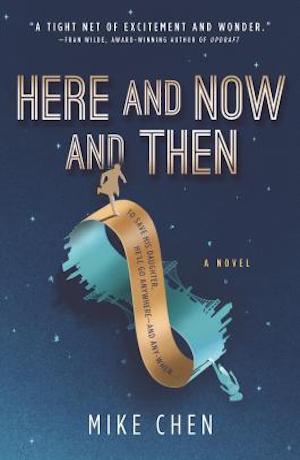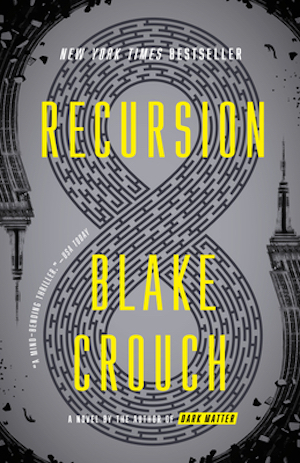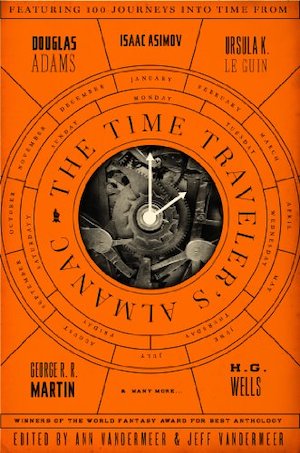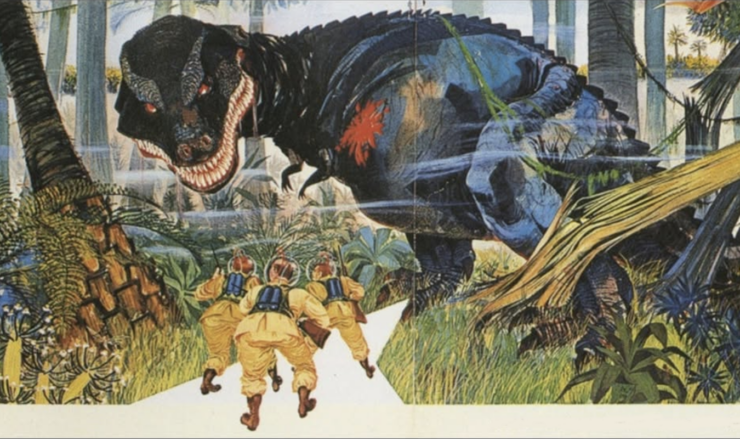If Marty McFly has taught us anything, it’s that messing with the past can lead to some pretty serious and harmful consequences in the future, but there are some time travel stories where the sci-fi concept is fairly harmless. In Toshikazu Kawaguchi’s Before the Coffee Gets Cold (2015), for instance, the focus is on healing personal relationships, rather than causing problems with the established timeline. Then there are the many wonderful time travel romances, where the stakes are also often limited to the individual level (more “will falling in love free me from this time loop?” and less “will the entire universe collapse in on itself?”).
But let’s consider the time travel stories that explore the various ways in which time travel can go very wrong and/or be incredibly dangerous—think people being trapped in deadly situations and whole timelines being erased or irrevocably changed. Here are five such stories.
Kindred (1979) by Octavia E. Butler

It’s 1976 and Dana is celebrating her 26th birthday with her husband in their new home in California when she’s suddenly ripped through time and space to find herself on a Southern plantation in the early 1800s. Before she’s even had the time to process what just happened, she hears a child drowning in a nearby river and springs into action. Almost immediately after saving the boy, she just as abruptly finds herself back in her house in L.A.
Over the course of the story, Dana is pulled back in time to this plantation for longer and longer chunks of time. This is a particular problem due to the fact that she’s Black and is therefore treated as a slave. While the mistreatment of enslaved people is a large—and important—part of the story and is absolutely brutal to read about, Butler’s narrative is also a brilliant exploration of different types of agency and modes of resistance.
Despite the challenging subject matter, I sped my way through Kindred—eager to see Dana’s attempts to control both her increasingly difficult life in the past and learn more about the mysterious mechanics of the time travel itself.
Here and Now and Then (2019) by Mike Chen

Kin Stewart is from 2142 and works (or, rather, worked) as a secret agent who travels through time. But things went wrong on a mission in 1996, leaving Kin stranded. With no other option—and suffering from memory loss—he set about creating a normal life by getting a job in IT, getting married, and having a kid. The story kicks off with rescue finally arriving—18 years too late (although, in fairness, it’s only been a few weeks in their timeline). Kin now finds himself torn between two families split across different time periods.
Kin’s very valid life crisis would be enough to deal with on its own, but he then starts messing around with the rules of time travel for the sake of his daughter—a decision that has some pretty dire consequences. Here and Now and Then has this compelling father-daughter relationship at its emotional core, but I also loved getting into the details of how the time travel agency, the Temporal Corruption Bureau, actually works.
Recursion (2019) by Blake Crouch

Recursion starts with NYPD detective Barry Sutton attempting to stop a woman from ending her life. She has a new disease—False Memory Syndrome (FMS)—which has recently started spreading, and the disease is generating memories of a son who doesn’t exist in the current reality. Barry starts to investigate FMS after this distressing encounter and it eventually leads him to Dr. Helena Smith, a neuroscientist whose research into Alzheimer’s disease may have accidentally resulted in the creation of time travel.
From pretty much start to finish, Recursion is a propulsive, twisty, and chaotic thrill ride. Barry and Helena know that it’s incredibly messy to interfere with the past, but if they want the present to go back to normal, then they don’t have any other choice.
“A Sound of Thunder” (1952) by Ray Bradbury

The idea of a butterfly flapping its wings and causing a tornado on the other side of the world was first put forward in 1972 by Edward Norton Lorenz (although both he and other scientists had been developing the idea before that). But in the realm of fiction, at least, Lorenz and his “butterfly effect” had been beaten to the punch by Ray Bradbury, who 20 years earlier had written a story which illustrated the idea that great changes can spring from seemingly insignificant origins with the untimely demise of just one winged insect.
In “A Sound of Thunder,” Time Safari Inc. is a company that will take anyone willing to pay an incredibly high price tag back to the prehistoric period to hunt and shoot a dinosaur. The company is aware that small changes in the past could snowball into huge changes in the present, so specific dinosaurs—ones that already have one foot in the grave for whatever reason—are pre-selected for clients to kill and they’re led through the experience under very tight parameters.
But it turns out that those parameters weren’t tight enough, because it takes just one member of a hunting party freaking out when he sees a T-Rex—causing him to disastrously step off of the pre-planned path—to set history on the wrong course.
“Through the Flash” (2018) by Nana Kwame Adjei-Brenyah

There’s been plenty of debate over how long Phil is trapped in his time loop in Groundhog Day (1993); most estimates fall somewhere within the 10 to 40 year range. This is enough time for Phil to be driven to desperate measures, attempting to end it all via various painful methods out of despair. But imagine being just 14 years old when you became trapped in a time loop… and then imagine it going on and on forever.
That’s the situation that Ama finds herself in, but she isn’t alone in the loop, with the rest of the residents in her neighborhood also being subjected to the same strange timey-wimey phenomenon. At the end of each day a nuclear explosion—known as the Flash—wipes everyone out and the day resets. You might think that having other people to share in the hellish experience would ease the mental burden, but the characters in “Through the Flash” are there to prove you wrong. And yet, for all of the external violence and internal strife in the short story, it ends on a relatively hopeful note.
These five stories are, of course, just a very small selection of the many tales that explore the various calamitous consequences of messing with time. Feel free to leave your own suggestions in the comments below…











Personally, I would use time travel to catch up on my reading, as there always seems to be too many books and not enough time…
I was pleased to see a familiar orange cover; The Time Traveler’s Almanac.
This is an excellent collection of stories. Highly recommended.
( I wonder if using my Time Machine to ensure I am first to comment on any post is an appropriate use of temporal technology? )
Me too! It is an excellent collection of time travel stories. Not a clunker in the bunch.
I’m going to have to copy your idea and use time travel for getting to all the books too!!! Such a good idea (Given we don’t age according to present time when in the past?)
A properly calibrated chroniton flux capacitor should ensure that time travel doesn’t adversely age us, I would think.
I’ve never been a big fan of time travel, but the way you describe books makes me want to read all of these! Kindred sounds so unique and amazing and I don’t think I’ve ever heard of anything like it before! And I obviously can’t resist a compelling father-daughter relationship, so Here and Now and Then is an obvious add to the TBR!
I originally read that Bradbury story as a kid in the late 80’s or early 90’s and for an embarrassing amount of years had not heard of the other Butterfly effect. So every time someone would describe it I would get all confused and be like, no, that’s not the effect, this is the butterfly effect and start rambling about time travel and T-Rex’s, lol.
Was the scientific term named for the story?
No, Edward Lorenz was unaware of the Bradbury story when he started using the term “butterfly effect,” which was suggested to him by Philip Merilees. Here’s a short research paper discussing the origin of the term (odd to see a scholarly paper researching the name for a physics principle rather than the principle itself):
https://physics.csuchico.edu/ayars/427/handouts/AJP000425.pdf
There’s an interesting “Note added in proof” in the Acknowledgments of the above paper, where the butterfly metaphor may actually predate its use by both Merilees and Lorenz. It was a 1969 paper by Joseph Smagorinsky.
It appears both Lorenz and Merilees read that paper. The implication seems to be that their use of the metaphor may have been a subconscious borrowing.
The paper, “Problems and promises of deterministic extended range forecasting,” can easily be found online. A search in the PDF for “butterfly” brings up 4 occurrences of the phrase “flutter of a butterfly’s wings”.
So where did Prof. Smagorinsky get the idea from?
No doubt it’s simply that butterflies have been a recurring symbol of smallness and delicacy throughout history, as well as just a general symbol of beauty, love, transformation, and other things, so that someone wishing to convey a striking image might well choose to follow millennia of precedent and invoke butterflies. Heck, I’ve done it myself. One of my proudest creations was my novelette “The Caress of a Butterfly’s Wing,” whose title I chose to evoke the delicacy, beauty, and ephemerality of butterflies. My story collection Among the Wild Cybers, which includes that novelette as its final story, features a symbolic cover image of a butterfly about to land on a robot’s extended hand.
As discussed in the paper, Lorenz’s original metaphor involved a seagull’s wings, but on discussion with peers, they decided a butterfly would be a more evocative symbol. And that’s because it always has been. Symbols work because they’re widely known and agreed upon, so it’s kind of pointless to look for a single recent inspiration for the use of a symbol. No doubt Bradbury chose a butterfly for the exact same reason, because it was a widely understood symbol for something small and delicate, something seemingly inconsequential, so that the contrast with its larger-scale impact is more striking.
There’s also the Lorenz Attractor in fractal geometry which demonstrates sensitive dependence on initial conditions by drawing a butterfly…
https://en.wikipedia.org/wiki/Lorenz_system
Yes, that came up when I looked into it, but as mentioned in the paper I linked to, those butterfly-like visualizations were not created until years after Lorenz adopted the butterfly metaphor. Presumably, plotting the attractor in that particular way became popular after the fact because it coincidentally produced a vaguely butterfly-like result.
Not to kill a great story, or a physics theory, but both versions of the butterfly effect depend on a strictly deterministic universe. Once you add any amount of randomness (stochasticity to use the big fancy science word), the effect disappears. There was a big debate about the effects of chaos (an odd name for a deterministic effect) in my corner of the science world: how population numbers change over time (population dynamics). Some simple computer simulations (run on mainframes!), killed the idea. That is not to say that small differences in starting conditions will not lead you down different paths, but not for long and not due to something as small as a butterfly flapping it’s wings. And I am forced to note that butterflies originated in the Eocene, only 40-50 million years ago; sorry Bradbury.
To be fair, Lorenz’s initial analogy was a seagull flapping its wings. I don’t think anyone meant the butterfly thing literally, just as an analogy for how a small change at the right moment can be chaotically amplified to have a decisive effect. But of course, it has to be at the right moment. I think a lot of people misunderstand the butterfly effect to say the hurricane is guaranteed to happen, when the whole point is that it’s impossible to make a prediction with deterministic certainty. Most of the time, a small change will just be damped out. A hundred pebbles could roll down a hillside, but only the one that hits at the right place and time will cause a landslide.
No, Dormammu: I am here to bargain…
“The Anubis Gates” by Tim Powers, where the time traveler discovers just how and why he had to be where he ended up in the past. Major bootstrap-paradox stuff going on.
Fritz Leiber’s Snakes and Spiders stories, including the novel “The Big Time” and the example of the short story “Try and Change the Past”. A guy gets three chances to go back and fix something. Time doesn’t cooperate.
The fun part is that the song in there can be sung to the tune of “Lili Marlene”.
One of the books named, ‘Recursion’, was a helluva read and also good in audiobook form. I read it several times just because it was so well done!
Blake Crouch has a great way to build tension and not blather on too much away from point of book, appreciate that always.
There’s always Connie Willis’ To Say Nothing of the Dog,’ “The Doomsday Book” and the “All Clear” Duology.
“All You Zombies” anyone? A Heinlein story about a single mother (sort of).
I have a growing interest in time travel fiction. I loved “Through the Flash,” did not terribly enjoy Recursion, and am looking forward to reading the other three.
Nothing from Jodi Taylor? Really?
All Our Wrong Tomorrows.
All Our Wrong Todays by Elan Mastai? I quite liked it except the bit about eradicating all old buildings. What, why? And it’s not even possible on a human timescale.
Connie Willis’s Doomsday Book, To Say Nothing of the Dog, All Clear, and other books in that same time travel going wrong universe are all different and very interesting views on how time travel goes wrong.
Thank you for mentioning Bradbury’s “Sound of Thunder”.
I didn’t realize it was from the early 1950’s when I read it (having been born in 1948 and not reading at that level in 1952…), but it has always stuck with me when time travel is mentioned.
Whenever someone mentions “A Sound of Thunder,” I feel the need to mention “Brooklyn Project” by William Tenn. Meant as a political satire (which still hits hard today), it dealt with the same concept a few years earlier and, I feel, in a much more entertaining way. Displacing even a relatively small amount of molecules a billion years in the past affects the present in a radical way.
No love for “The Rise and Fall of DODO”? It’s a dense book (as to be expected by one co-authored by Neal Stephenson) and requires more than one read to really “get” it all, but there’s also so much going on, much of it hilarious (Vikings at Walmart!). Basic premise: discovery of time travel by pure academics to better study history is suborned by US military for psy-ops missions throughout history, but everyone involved has their own agenda and they inevitably all collide.